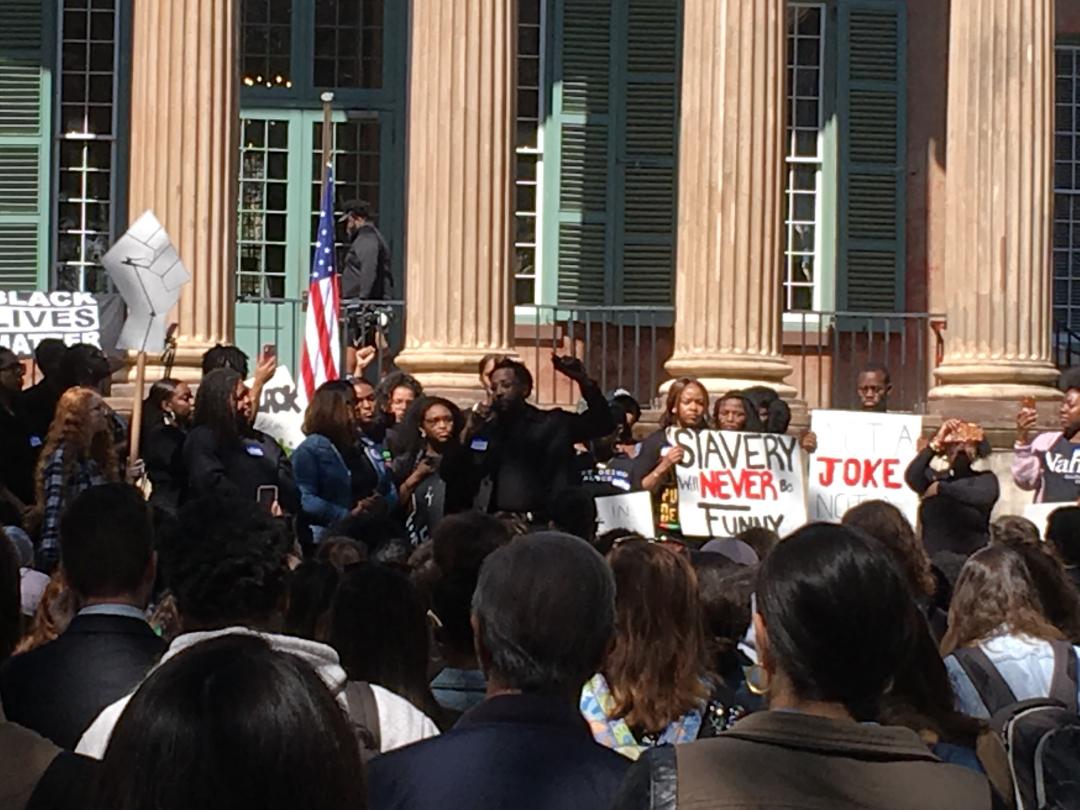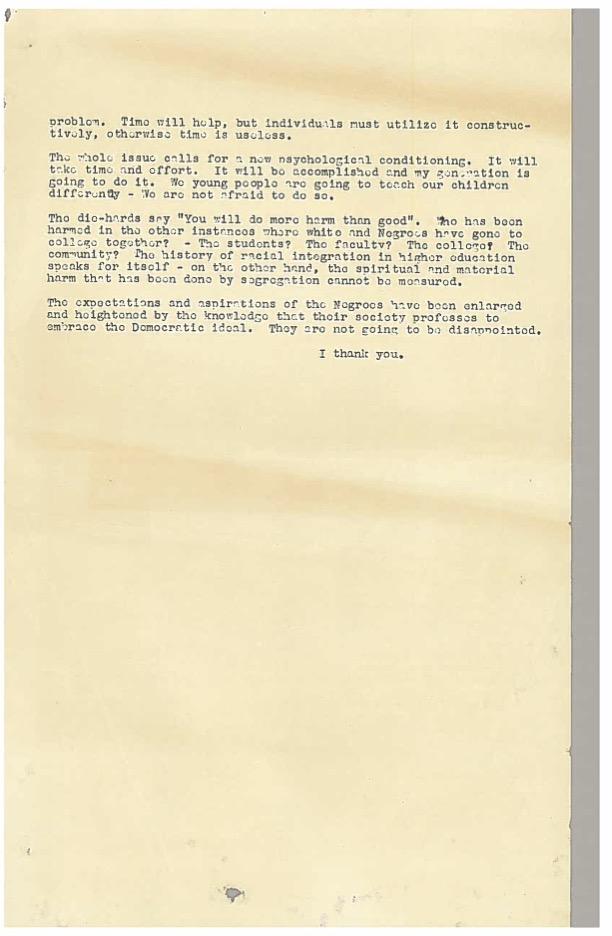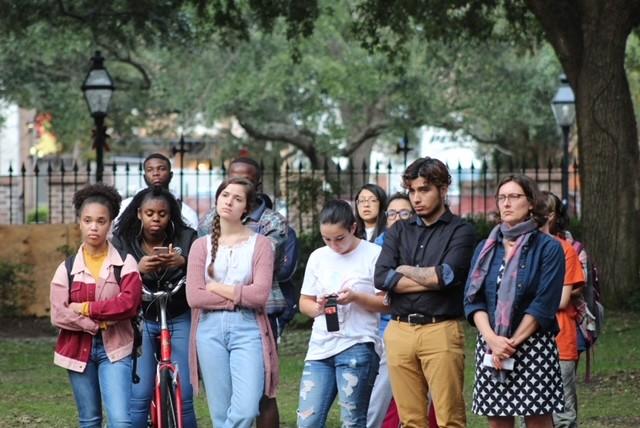Dreaming: Student Activism at the College of Charleston

Randolph Hall and Cistern Yard: two of the College’s most iconic sites. Beneath their dignified appearance, they represent contentious sites in the struggle for liberation.
Randolph Hall and Cistern Yard: two of the College’s most iconic sites. Beneath their dignified appearance, they represent contentious sites in the struggle for liberation. Randolph Hall has served white men for most of the College’s history. Outside its hallowed doors, the Cistern Yard has been a gathering place for all students—including those who are marginal to power. Each space represents an important moment in the history of student activism at the College of Charleston.
This institution has long been a site of struggle for recognition. The US South has changed, and along with it, so has the College. As students who are not white, male, protestant Christian, and straight were admitted, these students developed collective organizing tactics that put significant pressure on the central administration. In 1943, over two decades before the College’s desegregation, Black students at the Avery Normal Institute applied for admission to the College of Charleston. Rather than respond with a decision, administrators simply acknowledged the request. This was a well-worn tactic for maintaining power in the face of legitimate demands for change. In either case of acceptance or rejection of Black students, white administrators would have had to deal with the controversy of such a decision. In this case of silence, administrators remained “neutral.” In effect, their response perpetuated racism.
So did the “separate but equal” doctrine of the 1896 Plessy v. Ferguson court case, which paved the way for legalized segregation in public spaces, including schools. African American students across the nation suffered from access restricted to second-rate educational facilities, supplies, and books. The court system became a battleground for change. Black plaintiffs in cases such as Murray v. Pearson, Missouri ex rel. Gaines v. Canada, and Sweatt v. Painter all cited a violation of their 14th Amendment rights to change higher education systems, while the 1954 Brown v. Board of Education decision desegregated K–12 schools. Preempting the legal mandate to open its doors to all, the College of Charleston became a private institution in 1949. The City of Charleston shirked its responsibility to the public good by selling the College of Charleston charter to a private Board of Trustees—for the price of $1.
Two years later, in 1951, the voice of one white male student rang across campus. At the annual Bingham Oratorical contest held at Randolph Hall, Francis “Frank” Sturcken delivered a speech advocating for the College of Charleston’s desegregation. Its title, “The Liquid South,” referred to the region’s shifting political sensibilities. Sturcken developed what he calls the “Christian democratic” point of view as a moral justification for desegregation.
At the time he delivered the speech as a senior, Frank Sturcken had already won the Bingham Oratorical Medal twice; it came as no surprise that the faculty judges selected him again as a winner. He was active on campus as a member of Pi Kappa Phi fraternity and the Newman Club, a Catholic student organization he led in his junior year. To him, desegregation was a moral obligation to freedom and equality.
Given that Sturcken was the apparent beneficiary of segregation, he was not acting only in his own self-interest. His impassioned argument was also multidimensional. He cited the contemporary legal justification for segregation, the disparities in the cost of college between African American and White students, and the marring effect segregation had on spiritual wellness. He even referred to his own experience of losing his “artificial superiority over the Negro [sic] race.” Having grown up just over a mile away at 729 ½ King Street, Sturcken was a Southerner. This is how he offered his own redefinition of the South.
To get a sense of how common Sturcken’s perspective was, we can look at the survey he conducted of his White classmates. While the overwhelming majority gave affirmative answers, 36% said they did not believe African Americans should be admitted to the College of Charleston because they do not “have the moral or ethical right to attend.” On another question, 14% responded that they would “antagonize attending classes with [Black students].” This minority was not insignificant, but these figures revealed that the administration acted contrary to the wishes of the majority.
Sturcken’s speech was not just reprinted in newspapers in South Carolina, but across the country: from New Orleans to New York, Sturcken received many letters of support. They were from both Black and white people, everyday citizens and civil rights leaders alike. Judge Julius Waties Waring was one. The same year Sturcken delivered his speech, Judge Waring, a fellow Charlestonian and College of Charleston alum, wrote the controversial dissenting opinion in support of desegregating Clarendon County Schools. He contacted and then met with Sturcken following the speech. One Black civil rights leader, Dr. Benjamin E. Mays of the Southern Conference Educational Fund, wrote a column expressing concern over the consequences young Sturcken could suffer for his bravery. Mays sympathetically predicted, “he will be ostracized socially, doomed economically, and defeated politically” in the fallout from his speech. Unfortunately, Mays was right. Following his speech, Sturcken was blacklisted by the administration, including the segregationist President George Grice. This was not helped by the ambiguous position of the faculty. Although it was faculty members who award the Bingham Oratorical Medal, it was also faculty who attempted to dissuade Sturcken from speaking on the subject in the first place.
This mistreatment pales in comparison to the violence African Americans faced in the Jim Crow South. Furthermore, Sturcken’s speech was not without fault. The speech represented the colorblind race liberalism of its time. Its outdated language included a slur and erased Black women. And at times, it assumed a self-righteous tone. Despite, or even because of, these disappointments, Sturcken’s speech has a great deal to teach us in how to use one’s own position and background in the fight for justice. First in 2018 and again in 2020, the Sturcken Memorial Oratorical Competition gave students a platform for freedom of expression and progressive institutional change inspired by Sturcken’s bravery. (His daughter Elizabeth Sturcken travelled to support it both times.)
______________________
Whereas there are several examples of individual students at the College challenging the established power structures, there are many more examples of collective action. There are also several examples of students exercising First Amendment rights to freedom of assembly, on and around the College of Charleston campus. In 1960, Burke High School students held a sit-in at the segregated Kress Building just a block from campus. In 1985, Black students protested their exclusion from the 200th anniversary celebration at the College of Charleston. In 2014, students protested the State legislature’s backlash over the College’s selection of Fun Home, a lesbian coming of age graphic novel, for, The College Reads!, the campuswide common book program. When I was a junior at the College of Charleston, there was another protest. For the second year in a row, fellow students had dressed up in racist Halloween costumes. Students assembled to express righteous anger over this racist spectacle right here on the Cistern Yard. Students of all different backgrounds formed the Intersectional Cougar Action Network (I-CAN): a coalition of all marginalized student groups on campus.
Although we assembled to protest anti-Black racism, our ethos was to nurture connections between communities both for healing and institutional change alike. Student activists from across campus joined together to work from multiple angles, leveraging leadership positions in various student organizations across campus. As a team, however, we avoided official recognition as a student club. This allowed us to escape unstated institutional priorities but also meant we had to get creative to secure institutional resources, like meeting spaces and event funding. We wrote letters addressed to the administration about the current state of campus, and we worked for sustainable institutional change. We arranged countless meetings over the course of five years to pass the curriculum requirement for Race, Equity, and Inclusion. We saw right through the timeless message of administrators and Student Government alike, that “now isn’t the time” and “we’re going to make others angry.” Thanks to peer mentorship, the coalition has remained. All sorts of people were represented: women, men, nonbinary, and transgender people; Black, Latinx, white, and Asian-American peoples; secular, along with peoples of Jewish, Christian, and Buddhist faiths; straight, gay, lesbian, queer folks; people with various economic backgrounds, from different parts of the country. We invited everyone to the table because we believed everyone has a valuable perspective. We stayed there because we believed our fates are bound together.
If the College of Charleston really is “the most firmly entrenched stronghold of tradition in the country,” as Sturcken said it was, we have much to learn from the spirit of student activism. Although this spirit has at times receded, especially in the present moment, as institutions absorb and weaken the rhetoric of struggles for liberation, students continue to dream of a just world. They work beyond simple campus reform through Student Government, grievances, and efforts to simply “raise awareness.” When I think back to my days as a student activist, I’m proudest of how we braided solidarities across lines of difference. It was hard, but what would a campus be without the relentless hope and idealism of students? Tell me, how would our world fare without demands that we finally live up to our nation’s promises? That students do this while students—amidst study breaks and breakups, through the joys and sorrows of growing up—is amazing. It lends a durable understanding of what it takes to repair this broken world. We can’t give that up now.
Images







